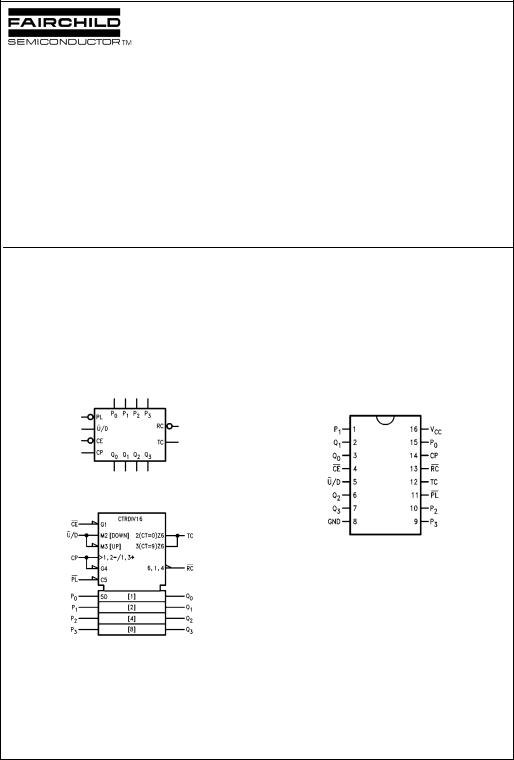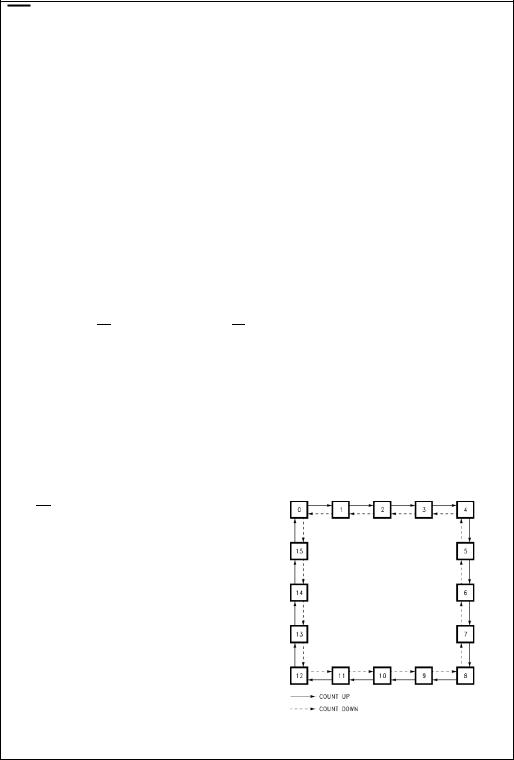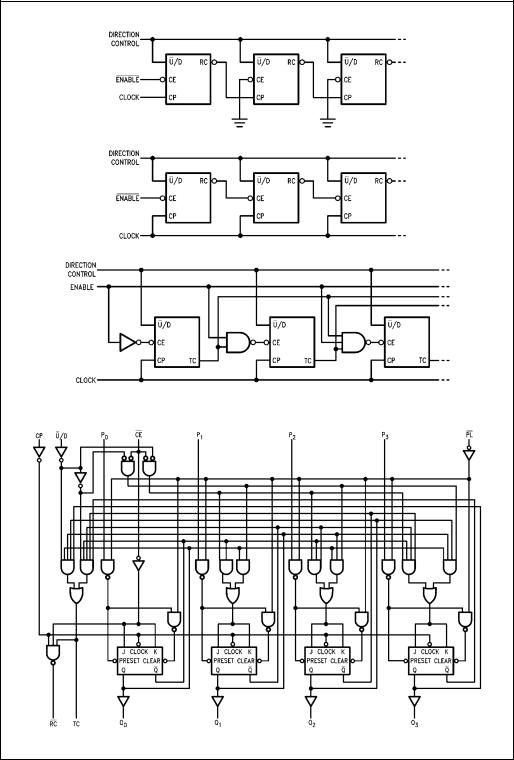Fairchild Semiconductor 74AC191SJX, 74AC191SJ, 74AC191SCX, 74AC191SC, 74AC191PC Datasheet
...
November 1988
Revised November 1999
74AC191
Up/Down Counter with Preset and Ripple Clock
General Description
The AC191 is a reversible modulo 16 binary counter. It features synchronous counting and asynchronous presetting. The preset feature allows the AC191 to be used in programmable dividers. The Count Enable input, the Terminal Count output and the Ripple Clock output make possible a variety of methods of implementing multistage counters. In the counting modes, state changes are initiated by the rising edge of the clock.
Features
■ICC reduced by 50%
■High speed—133 MHz typical count frequency
■Synchronous counting
■Asynchronous parallel load
■Cascadable
■Outputs source/sink 24 mA
Ordering Code:
Order Number |
Package Number |
Package Description |
|
|
|
74AC191SC |
M16A |
16-Lead Small Outline Integrated Circuit (SOIC), JEDEC MS-012, 0.150” Narrow Body |
|
|
|
74AC191SJ |
M16D |
16-Lead Small Outline Package (SOP), EIAJ TYPE II, 5.3mm Wide |
|
|
|
74AC191MTC |
MTC16 |
16-Lead Thin Shrink Small Outline Package (TSSOP), JEDEC MO-153, 4.4mm Wide |
|
|
|
74AC191PC |
N16E |
16-Lead Plastic Dual-In-Line Package (PDIP), JEDEC MS-001, 0.300” Wide |
|
|
|
Device also available in Tape and Reel. Specify by appending suffix letter “X” to the ordering code.
Logic Symbols
Connection Diagram
IEEE/IEC
Pin Descriptions
Pin Names |
Description |
|||||
|
|
|
|
|
|
|
|
|
|
|
|
|
Count Enable Input |
|
CE |
|
|
|||
|
CP |
Clock Pulse Input |
||||
|
P0–P3 |
Parallel Data Inputs |
||||
|
|
|
|
Asynchronous Parallel Load Input |
||
|
PL |
|
|
|||
|
|
|
Up/Down Count Control Input |
|||
|
U |
/D |
||||
|
Q0–Q3 |
Flip-Flop Outputs |
||||
|
|
Ripple Clock Output |
||||
|
RC |
|
||||
|
TC |
Terminal Count Output |
||||
|
|
|
|
|
|
|
FACT is a trademark of Fairchild Semiconductor Corporation.
Clock Ripple and Preset with Counter Up/Down 74AC191
© 1999 Fairchild Semiconductor Corporation |
DS009940 |
www.fairchildsemi.com |

74AC191
RC Truth Table
|
|
|
|
|
Inputs |
|
Outputs |
|
|||
|
|
|
|
|
|
|
|
|
|
|
|
PL |
|
|
CE |
|
TC |
CP |
|
RC |
H = HIGH Voltage Level |
||
|
|
|
|
|
|
(Note 1) |
|
|
|
|
|
|
|
|
|
|
|
|
|
|
|
|
L = LOW Voltage Level |
|
H |
|
|
L |
|
H |
|
|
|
|
|
|
|
|
|
|
|
|
X = Immaterial |
||||
|
H |
|
|
H |
|
X |
X |
|
H |
= LOW-to-HIGH Transition |
|
|
|
|
|
|
= Clock Pulse |
||||||
|
H |
|
|
X |
|
L |
X |
|
H |
Note 1: TC is generated internally |
|
|
|
|
|
|
|
||||||
|
L |
|
|
X |
|
X |
X |
|
H |
|
|
|
|
|
|
|
|
|
|
|
|
|
|
Functional Description
The AC191 is a synchronous up/down counter. The AC191 is organized as a 4-bit binary counter. It contains four edgetriggered flip-flops with internal gating and steering logic to provide individual preset, count-up and count-down operations.
Each circuit has an asynchronous parallel load capability permitting the counter to be preset to any desired number. When the Parallel Load (PL) input is LOW, information present on the Parallel Load inputs (P0–P3) is loaded into the counter and appears on the Q outputs. This operation overrides the counting functions, as indicated in the Mode Select Table.
A HIGH signal on the CE input inhibits counting. When CE is LOW, internal state changes are initiated synchronously by the LOW-to-HIGH transition of the clock input. The direction of counting is determined by the U/D input signal, as indicated in the Mode Select Table. CE and U/D can be changed with the clock in either state, provided only that the recommended setup and hold times are observed.
Two types of outputs are provided as overflow/underflow indicators. The terminal count (TC) output is normally LOW. It goes HIGH when the circuits reach zero in the count down mode or 15 in the count up mode. The TC output will then remain HIGH until a state change occurs, whether by counting or presetting or until U/D is changed. The TC output should not be used as a clock signal because it is subject to decoding spikes.
The TC signal is also used internally to enable the Ripple Clock (RC) output. The RC output is normally HIGH. When CE is LOW and TC is HIGH, RC output will go LOW when the clock next goes LOW and will stay LOW until the clock goes HIGH again. This feature simplifies the design of multistage counters, as indicated in Figure 1 and Figure 2. In Figure 1, each RC output is used as the clock input for the next higher stage. This configuration is particularly advantageous when the clock source has a limited drive capability, since it drives only the first stage. To prevent counting in all stages it is only necessary to inhibit the first stage, since a HIGH signal on CE inhibits the RC output pulse, as indicated in the RC Truth Table. A disadvantage of this configuration, in some applications, is the timing skew between state changes in the first and last stages. This represents the cumulative delay of the clock as it ripples through the preceding stages.
A method of causing state changes to occur simultaneously in all stages is shown in Figure 2. All clock inputs are driven in parallel and the RC outputs propagate the carry/borrow signals in ripple fashion. In this configuration the LOW state duration of the clock must be long enough to allow the negative-going edge of the carry/borrow signal to
ripple through to the last stage before the clock goes HIGH. There is no such restriction on the HIGH state duration of the clock, since the RC output of any device goes HIGH shortly after its CP input goes HIGH.
The configuration shown in Figure 3 avoids ripple delays and their associated restrictions. The CE input for a given stage is formed by combining the TC signals from all the preceding stages. Note that in order to inhibit counting an enable signal must be included in each carry gate. The simple inhibit scheme of Figure 1 and Figure 2 doesn't apply, because the TC output of a given stage is not affected by its own CE.
Mode Select Table
|
|
|
|
|
Inputs |
|
Mode |
|||
|
|
|
|
|
|
|
|
|
|
|
|
PL |
|
CE |
|
U/D |
CP |
|
|||
|
|
|
|
|
|
|
|
|
|
|
|
H |
|
|
L |
|
|
|
L |
|
Count Up |
|
H |
|
|
L |
|
|
H |
|
Count Down |
|
|
L |
|
|
X |
|
|
X |
X |
Preset (Asyn.) |
|
|
H |
|
|
H |
|
|
X |
X |
No Change (Hold) |
|
|
|
|
|
|
|
|
|
|
|
|
State Diagram
www.fairchildsemi.com |
2 |

Functional Description (continued)
FIGURE 1. N-Stage Counter Using Ripple Clock
FIGURE 2. Synchronous N-Stage Counter Using Ripple Carry/Borrow
FIGURE 3. Synchronous N-Stage Counter with Parallel Gated Carry/Borrow
Logic Diagram
Please note that this diagram is provided only for the understanding of logic operations and should not be used to estimate propagation delays.
74AC191
3 |
www.fairchildsemi.com |
